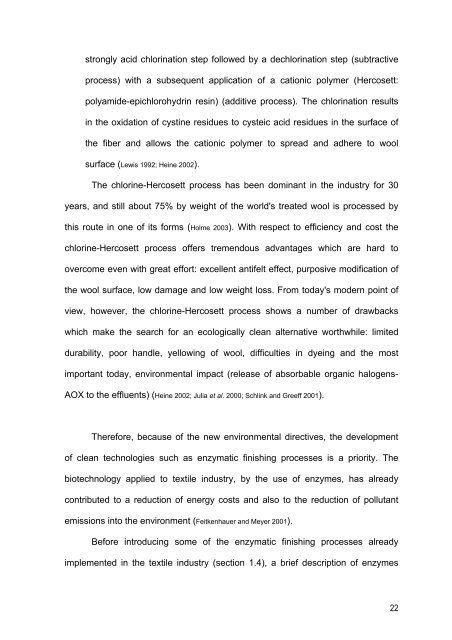Enzymatic Treatment of Wool with Modified Proteases
Enzymatic Treatment of Wool with Modified Proteases
Enzymatic Treatment of Wool with Modified Proteases
Create successful ePaper yourself
Turn your PDF publications into a flip-book with our unique Google optimized e-Paper software.
strongly acid chlorination step followed by a dechlorination step (subtractive<br />
process) <strong>with</strong> a subsequent application <strong>of</strong> a cationic polymer (Hercosett:<br />
polyamide-epichlorohydrin resin) (additive process). The chlorination results<br />
in the oxidation <strong>of</strong> cystine residues to cysteic acid residues in the surface <strong>of</strong><br />
the fiber and allows the cationic polymer to spread and adhere to wool<br />
surface (Lewis 1992; Heine 2002).<br />
The chlorine-Hercosett process has been dominant in the industry for 30<br />
years, and still about 75% by weight <strong>of</strong> the world's treated wool is processed by<br />
this route in one <strong>of</strong> its forms (Holme 2003). With respect to efficiency and cost the<br />
chlorine-Hercosett process <strong>of</strong>fers tremendous advantages which are hard to<br />
overcome even <strong>with</strong> great effort: excellent antifelt effect, purposive modification <strong>of</strong><br />
the wool surface, low damage and low weight loss. From today's modern point <strong>of</strong><br />
view, however, the chlorine-Hercosett process shows a number <strong>of</strong> drawbacks<br />
which make the search for an ecologically clean alternative worthwhile: limited<br />
durability, poor handle, yellowing <strong>of</strong> wool, difficulties in dyeing and the most<br />
important today, environmental impact (release <strong>of</strong> absorbable organic halogens-<br />
AOX to the effluents) (Heine 2002; Julia et al. 2000; Schlink and Greeff 2001).<br />
Therefore, because <strong>of</strong> the new environmental directives, the development<br />
<strong>of</strong> clean technologies such as enzymatic finishing processes is a priority. The<br />
biotechnology applied to textile industry, by the use <strong>of</strong> enzymes, has already<br />
contributed to a reduction <strong>of</strong> energy costs and also to the reduction <strong>of</strong> pollutant<br />
emissions into the environment (Feitkenhauer and Meyer 2001).<br />
Before introducing some <strong>of</strong> the enzymatic finishing processes already<br />
implemented in the textile industry (section 1.4), a brief description <strong>of</strong> enzymes<br />
22

















